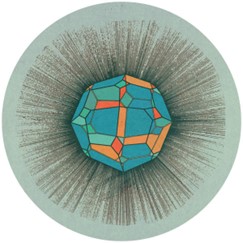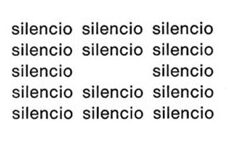
“You and I are the force for transformation in the world. We are the consciousness that will define the nature of the reality we are moving into.”
– Ram Dass
This two-part post reflects on Rebecca’s Writing Transformation workshop: if this inspires you, Rebecca will be running the workshop again – with a new part added – for St Andrews students, on Friday 10th November, 5-8pm at St Andrews Student Union (in-person only). Free to attend but booking required.
Background: concrete poetry
In May 2023, I ran a poetry workshop responding to some of the themes I’ve been addressing during my residency with the CEE. The workshop ran twice: once in-person at the Byre Theatre in St Andrews, and once online.
I called the workshop Writing Transformation, continuing to explore my twin fascinations of poetic form and poetry as an agent of change. What can a poem – and the form of a poem – tell us about the times we’re living in? How can it mirror, embellish, challenge or encourage our efforts as we strive for societal change? And as always, how is it all connected?
We began by looking at examples of poetry where form plays an active and crucial role. More specifically, concrete (also pattern, shape, or visual) poetry: where the layout of words on the page carries the same, if not more weight of meaning as the words themselves. Often, the poems function as much as visual art objects, and can be presented in both contexts.

‘Concrete poetry begins by being aware of graphic space as its structural agent, as the cosmos in which it moves’
Dom Sylvester Houédard, 1963.
Concrete poetry emerged from the Dada and Futurist movements of the early 20th century, growing in the 1950s alongside other post-war avant-garde movements in music, painting and sculpture. At the same time as Eugen Gomringer created ‘Silencio’ (above), John Cage composed 4’33” – where musicians are instructed not to play their instruments, but rather the performance is comprised of whatever environmental sounds take place within that time. The term Concrete was officially adopted by the Noigandres group in Brazil (Haroldo de Campos, Augusto de Campos and Decio Pignatari), after they showed work alongside visual artists in the National Exhibition of Concrete Art in 1956 at the Museum of Modern Art, São Paulo. Other key figures include the Scottish poet and artist Ian Hamilton Finlay, and Mary Ellen Solt in the US.
Typical forms include the use of typography, collage, colour; redaction (erasure, or blackout) poems, ‘found’ poems (created by adapting an existing text), and emergent poems. My own example here, The Declaration of Barrbru (in Scotia Extremis: Luath Press 2019, Eds Andy Jackson and Brian Johnstone) is both a found poem, using the advertising slogan of Barr’s Irn Bru where the poem resolves, and an emergent poem, with text (and new meaning) ‘emerging’ from within the source phrase, using only those words as ingredients. The letters appear like bubbles in a bottle. The poem’s title and long ‘tattered’ appearance also evoke the 1320 Declaration of Arbroath:
The Declaration of Barrbru

Concrete poetry’s popularity spread via small presses, zines and artist’s publishing, maintaining a subversive, often political character. Poets made use of – and commented on – technological developments of the time, as seen in works such as ‘The computer’s first Christmas card’ by Edwin Morgan (from 1968, in Collected Poems, Carcanet 1990); which is interesting to consider within current debates around AI (especially as it affects writers and artists). I strongly recommend exploring Morgan’s work for its inventiveness with language and form, and great humour. Other contemporary and as it happens, Scottish proponents of the form I also recommend are Alec Finlay and nicky melville.
Shape or pattern poetry predates the terming of concrete poetry. The terms are often used interchangeably, yet I tend to think of shape poetry as being more literal and having simpler intentions – for example, a poem about a bird in the shape of a bird. Concrete poetry tends to go deeper into the relationship between form and meaning – although the way this is achieved might play out very lightly in the poem’s appearance (just one of concrete’s many clever tricks). The term visualpoetry is usually used when there are images incorporated into the work via typography or collage.
A very early example of what we could call shape poetry, is also an excellent foothold for what would become Concrete: the ‘Abracadabra’ amulet from the 2nd century CE.

From Hebrew, “I will create as I speak”,or Aramaic “I create like the word”, it’s the reason we still think of Abracadabra as a ‘magic word’. It was first recorded in Liber Medicinalis by Serenus Sammonicus, physician to the Roman emperor Caracalla, who prescribed that malaria sufferers wear an amulet containing the word written in the form of a triangle. Written in the diminishing form as shown, the amulet would lessen symptoms or guard against infection altogether. Written the other way, increasing outward from the letter ‘A’ at the top of the triangle, the amulet would increase health and vitality.
In this same way, concrete poetry works by wearing its materiality on its sleeve. It’s playful and self-aware. Its game or puzzle-like nature encourages the reader to play an active role in deciphering the meaning/s of the poem, at times invoking a somatic response. Quite literally: you might have to tilt your head or turn the page, handling the poem as a material object. The reading process becomes embodied, interactive, even performative; the reader is an integral part of the process. And like the Abracadabra amulet, there can be something medicinal in this poetry: the poem portraying both the illness and the cure. By developing a more active awareness of the ways in which the surface operations of the poem lead us into deeper layers of meaning, so too can we begin to understand or imagine how other structures and mechanisms operate; positioning our own bodies, perspectives and privileges accordingly within those processes.
Tools for the times
To my mind, a successful concrete poem is more than the sum of its parts. Something alchemical happens between text, object, subject, spacing, shape, movement, inclusion and omission, sound and silence – and new meaning is created.
These are all useful tools when we’re thinking about making changes to our systems and structures; understanding how things work, what we want to do differently, and how. I find myself turning to concrete poetry in my own work when there’s something I want not only to say, but to show. Some examples from my last collection, Rough Currency (Tapsalteerie 2021):

What drilling does, I

What drilling does, II

The poem ‘E=’ was also used by the CEE as the logo for their 2023 conference ‘Financing the Future’. What drilling does, I and II present two views of the same action – each time asking the reader to consider their position: one in aerial view (What drilling does II), which simply repeats ad infinitum (or does it?); and one that excavates the layers, met as a horizontal cross-section. I think of What drilling does I as ‘semi-concrete’, where there is an active visual element at play (the inverted triangle and a process of diminishing or reduction), but the language of the poem could almost have taken any form (when read aloud, you can’t hear its concreteness).
During the residency and for my new collection, I’ve taken this approach into a form I’m calling ‘Attractors’, which I wrote about in an earlier post. To recap, an ‘Attractor’ poem is roughly square-shaped, to evoke a solar panel. And like a solar panel, the poem’s purpose is to attract attention (light) and energy towards the subject of the poem – a person, their work, experiences or viewpoint (an astronomer, a marine biologist, a climate scientist, an activist, a farmer…).

I have nine of these poems for the new collection (three sets of three). Along the way, I established several rules for their construction – helpful restraints that also give the poems their character and concreteness; that make them ‘work’. I wanted to highlight in the Writing Transformation workshop this notion that we can invent our own forms, concrete or otherwise. When there’s something we want to say – or show – we have the option of inventing a form that suits our very purpose. That’s not to say a sonnet, villanelle, or even free-verse (so-called, for there we make decisions all the time) won’t fit the bill – or even another newly invented form such as the Golden Shovel (Terrance Hayes, 2010 – I have one of those in the new collection too). But for us to consider, in these times of new tools, and new or recovered ways of thinking and sensing, how might a poem also be designed that’s specific to the task?




